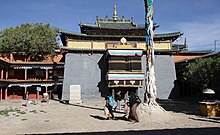| Shalu Monastery | |
|---|---|
Tibetan transcription(s) Tibetan: ཞྭ་ལུ། Wylie transliteration: Zhwa-lu Official transcription (China): Xalu THL: Zhalu Other transcriptions: Shalu Chinese transcription(s) Traditional: 夏魯寺 Simplified: 夏鲁寺 Pinyin: Xiàlǔ Sì | |
 | |
| Religion | |
| Affiliation | Tibetan Buddhism |
| Sect | Shalu Sakya |
| Location | |
| Location | Shigatse Prefecture, Tibet, China |
| Architecture | |
| Founder | Chetsun Sherab Jungnay |
| Part of a series on |
| Tibetan Buddhism |
|---|
 |
Shalu Monastery (Tibetan: ཞྭ་ལུ།, Wylie: zhwa lu) is small monastery 22 kilometres (14 mi) south of Shigatse in Tibet. Founded in 1040 by Chetsun Sherab Jungnay, for centuries it was renowned as a centre of scholarly learning and psychic training and its mural paintings were considered to be the most ancient and beautiful in Tibet. Shalu was the first of the major monasteries to be built by noble families of the Tsangpa during Tibet's great revival of Buddhism, and was an important center of the Sakya tradition.

